Asbestos Removal – Everything You Wanted to Know and More
This is the post that I’ve been putting off writing. Why? I was still dealing with the shock of it all. The gist of it is, if you think your home is safe from asbestos, you could be dead wrong! I thought our home was in the asbestos-free time frame, but I was sorely mistaken.
Background: What started as a small leak turned into a massive gut of our kitchen. The disaster restoration team came in and started assessing the damage. What happened next was a downward spiral of issues I pray never happens to you. The polybutylene pipe failure from two weeks ago turned into a full blown mold remediation (luckily it wasn’t black mold.) Shortly after removing the water soaked base cabinets in our kitchen, the project manager discovered old vinyl flooring under our newer vinyl flooring. He told me that they sent a sample to the lab for asbestos testing. I said, “Okay.” And dismissed it knowing that our house couldn’t possibly contain asbestos. The next morning I got a phone call, “The lab results came back and that old flooring tested positive for asbestos.”
What I learned over the next few days about asbestos both scared me and re-assured me. Now that our home is officially asbestos-free and we’ve finally moved back into the house, I’m emotionally ready to share with you what I learned.

Asbestos fibers under a microscope courtesy of Wikipedia Commons
What is asbestos? (source: EPA.gov)
Asbestos is a mineral fiber. It can be positively identified only with a special type of microscope. There are several types of asbestos fibers. In the past, asbestos was added to a variety of products to strengthen them and to provide heat insulation and fire resistance. Asbestos as a building material made sense before it was discovered to cause health problems. It was heat and fire resistant and the glues that contain asbestos work REALLY well. You can’t get glue for vinyl flooring today that sticks as well as the asbestos based glues. Thankfully, asbestos has been banned in the US.
But, here is the crazy thing: Back in the early 1900’s asbestos was suspected to be a health hazard. In 1924, a UK citizen was the first person diagnosed with Asbestosis (progressive fibrosis of the lungs.) In 1931, the term Mesothelioma (a rare form of cancer) was used in medical literature. But, the risks and dangers of asbestos were swept under the rug and hidden until the 1970’s. Finally, in 1989 asbestos in building materials was phased out and eventually banned in 2003. That is almost 80 years after the dangers of asbestos were first discovered! Which means that in the meantime asbestos was used in almost a million residences and buildings. And over 100,000 people have become ill or died from asbestos exposure.
Asbestos is used in (but not limited to) per Wikipedia:
- Roofing and siding materials
- Some roofing and siding shingles are made of asbestos cement
- Insulation of a home built between 1930-1950
- Attic and wall insulation as vermiculite ore
- Textured paint and wall patching
- Artificial ashes and embers used in gas fireplaces
- Old stove-top pads
- Walls and floors around woodburning stoves can have asbestos fiber, millwork or concrete pads
- Vinyl floor tiles and the backing on vinyl sheet flooring
- Vinyl floor adhesives
- Asbestos blanket or tape on hot water and steam pipes in older homes
- Oil and coal furnaces door gasket insulation
The bottom line is that your home could have asbestos products even if it was built in and prior to 2003. The asbestos abatement team told me that just because there was a ban placed on the use of asbestos, there were still products containing it on store shelves. For this reason, you should never assume that your home is asbestos-free. It is much safer to have a professional test for asbestos if you don’t know. Then discover that you were exposed when it is too late.
What to do if you suspect (and even if you don’t suspect) that you have an asbestos product in your home:
First of all, don’t freak out. Call a professional asbestos abatement company and have them do a quick test on the product. They will take a 1″ sample of the material and perform a PLM (Polarized Light Microscopy) test by looking for asbestos fiber structures under a microscope. If it is determined that you have asbestos, you need to determine the risk of the fibers being released into the air. If you have asbestos flooring that is in good condition (not flaking, damaged or will be tampered with) you can lay new flooring over top of the old floor. In the case of our vinyl flooring, one of the previous owners had added new flooring on top of the old. This is acceptable, but it must be disclosed that there is asbestos flooring in the home when you go to sell. It is presumably safe to live in a home that has asbestos products as long as they aren’t at risk of creating air borne fibers.
In our case, the mold remediation team had to remove the water soaked floor and would be damaging the old asbestos vinyl underneath. This could loosen and expose fibers that could be inhaled and potentially lead to health problems.
How Asbestos is Removed?
I was told that we could stay in the house during the abatement, but there was no way I was going to chance having my kids in the house. We decided to move everyone out of the house (complicated by the fact that we were getting headaches from the mold.)
The abatement team arrived and sealed off the room(s) completely. Doorways, ducts and even the windows are sealed with plastic. Big scary asbestos signs are placed on every doorway to deter people from entering.
Two giant HEPA filters are installed outside a window and suck the air out of the room. This creates negative air pressure which prevents air from escaping into the rest of the house.
The asbestos abatement team wears disposable suits (and I was told even disposable underwear.) They wear respirators and gloves.
The floor boards are cut into manageable sections and the edges are taped off to contain the asbestos backing and glue under the vinyl. The sheets are loaded into a truck. All debris is vacuumed and cleaned from the room and disposed of in plastic bags. All the contaminated materials, clothing, etc. are hauled back to the abatement company where they are dumped into a special sealed dumpster for asbestos products.
After the abatement team is done, they must strip down and take a shower (usually a portable shower is brought to the job site.) Only after the shower can they put on their regular clothes.
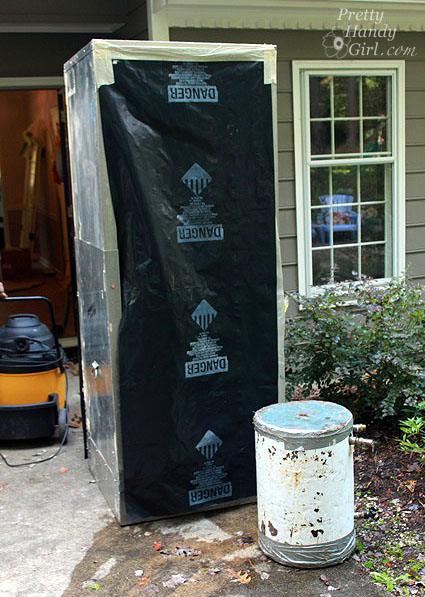 Portable shower for abatement team to use after finishing the job.
Portable shower for abatement team to use after finishing the job.
Air test for Asbestos
After the abatement is complete, an air test must be performed before anyone can enter the room without protective gear. A TEM (Transmission Electron Microscopy) or a PCM (Phase Contrast Microscopy) air sample is analyzed. In our house, the TEM was used which is supposedly more accurate. The technician was a trained professional who put on his own protective gear. He ran a leaf blower around the room to stir up any dust and fibers that may have settled on the floor and in crevices. Then ran a small vacuum pump that sucked air through a filter for 45 minutes.
An acceptable asbestos air test will come back with less than .01 fibers per cc. Luckily our home was clear and we were allowed to move back in. But, now this is our reality:
That’s right, we now have a scooter track in our home. I may miss our kitchen, but the boys don’t seem to mind.
To be continued…
You can read more about our kitchen disaster and renovation in these updates:
- Polybutylene Pipe Leak turns into Moldy Mess
- Planning New Kitchen Layout and more
- Planning Colors and Materials for the New Kitchen
- Let the Demolition Begin
- How to Remove Soffits
- Move Back in the Kitchen Temporarily and Throw a New Year’s Party
- Termite Damage and Kitchen Update
- How and When You Should File for a Permit during a Kitchen Renovation – Your Questions Answered
- Everything You Should Know about Termites and Termite Damage
- Structural Engineer Plans and another Kitchen Update
- How to Survive without a Kitchen During Renovation

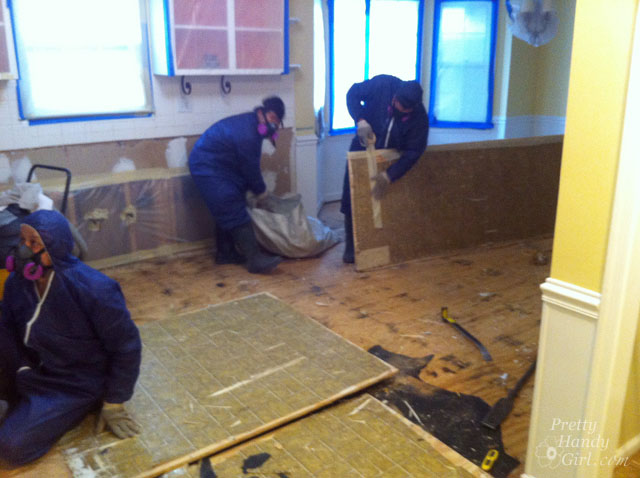
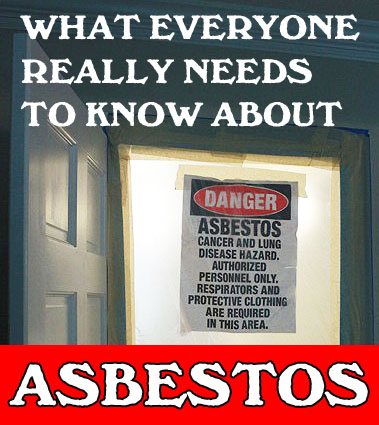
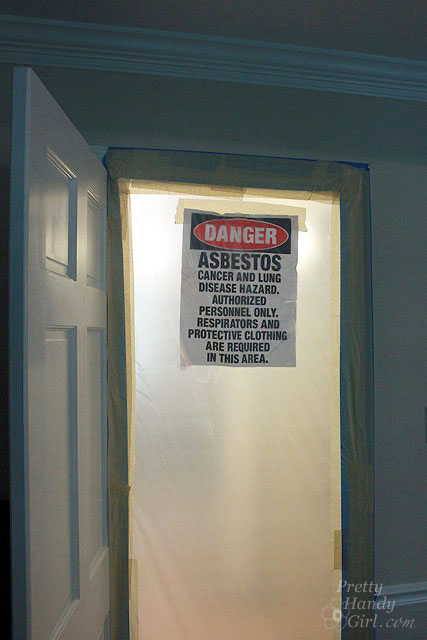
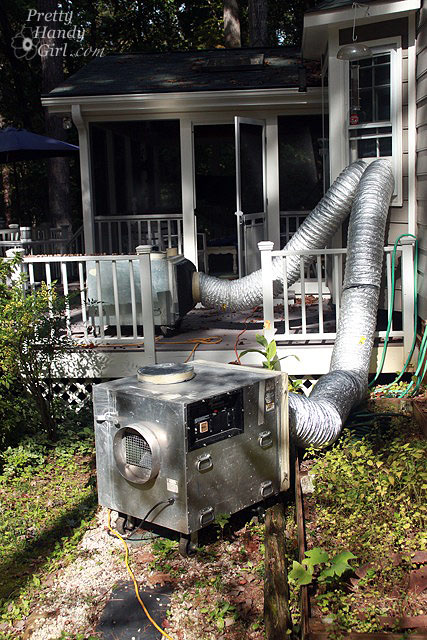
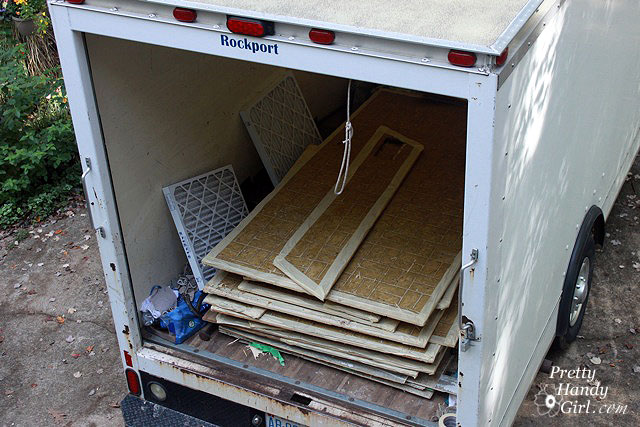
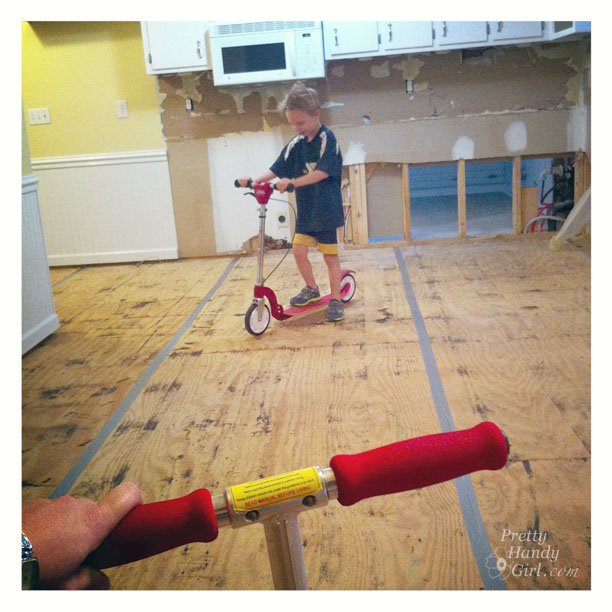



This is so helpful. Thank you. I am reading from Europe. My apartment in England is having asbestos floor tiles removed, after a leak, next week. I was very concerned about when it would be safe to move back in. I imagined needing to remove and replace all the carpets and furniture in the apartment, but perhaps that can be avoided.
Maybe you can help me ? I had a house fire march 3 of this year. The fire department did a awsome job putting it out fairly quick. When it was all said and done most of the fire damage was on 1 side of my home. The house was built in 1911 and has many face lifts. The rest of the house damaged by smoke. Firefighters put holes through out the house checking for hot spots. Walls, ceilings of most of house. Fast forward insurance company had tests done and we have asbestos at all locations. I’m being told that all my belongings in home can be cleaned? Clothes furniture. Everything. This doesn’t sound right. Any info you can share?
Matt, first, I’m so sorry this has happened to you. Regarding asbestos abatement, if it were me, I’d be okay with having smooth surfaces cleaned. If it was cloth or clothing (and it was outside during demolition) I’m not sure if I’d feel comfortable with those being cleaned. But, that’s just me. Maybe they have a way to strong vacuum the cloth items and then clean. But, that doesn’t address the smoke smell. I heard that’s near impossible to clean.
Hi we already figured it out we removed asbestos popcorn ceiling I was able to find a zero voc sealer encapsulation spray of that was sprayed on ceiling walls and all air in that room called Fiberlock- Fiberset PM
what do we use as a primer to ensure no particle dust remains but is encapsulated
Randi, I’m not sure what you mean? Where is the asbestos you are talking about? Typically asbestos in drywall or joint compound isn’t an issue if the walls have been painted. The danger is when you cut into the wall or pull the drywall down and release the fibers into the air.
Asbestos is not banned in the United States
I know this may be personal, but do you know the costs for all of these tests. We have insulation that is deterating and it’s asbestos. We need to get it removed ASAP. But I’m wondering how much money we’re looking at.
The tests aren’t very expensive. It depends on your lab and if you are set up as a contractor (plus how quickly you need the results.) But,I’d say around $50 – $70 per sample. The real expense comes to have it abated.
where do the companies put the hazardous stuff after it goes into their dumpsters? Does anyone have a way to break it down and destroy it? Are our dumps filled with this asbestos?
It is put in a separate sealed area in the dump.
I am having this done in my own house soon. How many days did you have to stay out of the house?
Two days. The abatement was done in a few hours. But, we had to wait for the air sample tests to come back clear.
I am so thankful I have not had a run in with asbestos. Thankfully it was banned in the 80’s and construction companies use other means, which is beneficial for all of us. I plan on just living in homes that were built post-1980 and hope that it does not come back and bite me. Thanks for all the information!